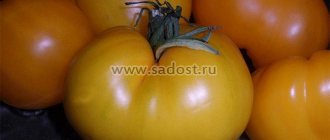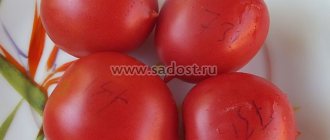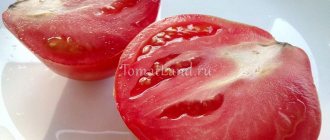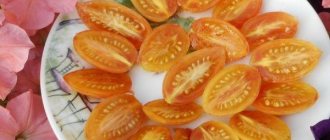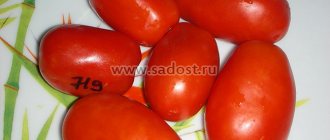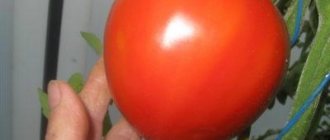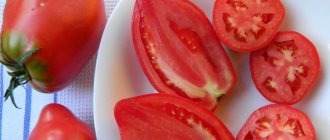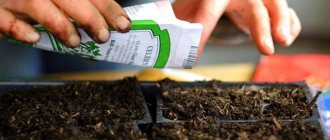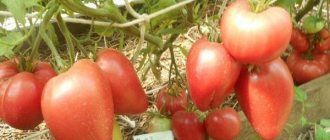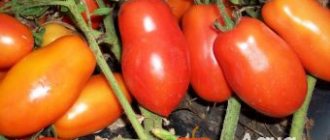Lemon-liana
A very interesting variety of liana-shaped tomato is Lemon Liana.
Its lashes reach a height of 3 m. And it is not without reason that next to the first name of this variety they put the second one - Wonder of the World. This variety has simply huge clusters, which can contain up to 50 fruits each! The variety is extremely productive and resistant to unfavorable growing conditions. Due to the huge brushes, the variety needs support and garter. Beautiful, lemon-colored tomatoes are very tasty and juicy, ideal for canning and table decoration. The size of the tomatoes is small - 60-100 g. The variety is mid-early, tall. Suitable for growing in open ground, but for its intended purpose it is a greenhouse variety. Slightly smaller bushes of the Midas variety, which we often call Medok for its excellent honey taste. Medoc is also distinguished by its original shape of yellow fruits, more like pears. Looking at the bushes of this variety, it seems that it has more fruits than leaves.
The taste of Medok is very similar to the Honey Spas variety. Only its fruits are yellow-pink, and its shape is rounded and elongated.
Tomato Lemon Liana (Wonder of the World)
Tomato Lemon Liana (Wonder of the World)
Tomato Midas
Reviews from those who planted
Olga, Moscow region
I started growing this tomato two seasons ago. Although you have to tie up tall shoots and constantly apply fertilizer, the amount of fruit collected justifies everything - enough for both fresh consumption and canning. Last season, I distributed buckets of ripe tomatoes to my relatives and friends - the harvest was so bountiful.
Sergey, Voronezh
I was amazed by the high resistance of the variety to diseases - tomato bushes of a different variety were growing in a neighboring bed, and they became sick with gray rot. I fought the disease and sprayed Lemon Liana bushes as a preventive measure. But one bush remained untreated, and still did not get sick.
Maria, Safonovo
It’s simply incredible: we carry the harvest from the greenhouse in buckets. I ordered the Lemon Liana tomato from a catalog. I really liked both the description and the view. The harvest began to ripen in August. I did everything as recommended: fertilizing, watering, careful garter, and so on. Based on the harvest, I realized that the description was inaccurate, since my tomatoes had 9 clusters with many fruits. And how big they are! I didn't even expect such wealth. We collected tomatoes in buckets, enough for both the children and us. They just miscalculated a little with the garter - several stems broke under the weight of the harvest. Well, it’s okay, now we have experience, and Lemon Liana tomatoes are now our favorite.
The soil
There are special requirements for soil for tomato seedlings. First of all, the soil should be light; the fruits cannot tolerate stagnant moisture, which negatively affects their growth. Garden soil is best suited for this. A little humus is added to it. Some gardeners add a small amount of sand taken from the river.
The soil is poured into specially prepared containers and a depression of up to 1.5 cm is made, placing tomato seeds there. Then the soil is sprayed with water, the pots are placed in a warm place.
The most suitable temperature for germination ranges from 22 to 25 °C. The containers are left in a warm place until the first shoots appear.
If the cultivation of tomatoes is followed according to all the rules, the first shoots will soon appear. As soon as the shoots grow, the seedlings are exposed to bright light. When the first pair of leaves appears on the sprouts, the tomatoes can be picked, distributing them into separate pots. Instead of a soil mixture, summer residents often choose peat tablets. It is convenient to plant them in the soil along with tomato sprouts.
Under no circumstances should areas with tomatoes be thickened. For 1 sq. m it is recommended to place no more than 3 bushes. The Lemon tomato is quite tall, so it is better to attach it to trellises. Since it has a good yield, it is better to hang heavy branches with fruits.
As it grows, the lower leaves and side shoots are removed. In this way, a tomato bush with 1 or 2 stems is formed. During the entire growing season, vegetables need to be fed with a full range of fertilizers. For this variety, the procedure is repeated no more than 3 times. For irrigation, you need to use exclusively warm, settled water. Water not often, but generously.
Agrotechnics of cultivation
Tomato is cultivated by seedling method. 2 months before the expected date of planting in the ground, the seeds are placed in containers with moistened soil to a depth of 1 cm. Before sowing, they are pre-soaked in a solution of potassium permanganate.
Caring for seedlings involves periodic watering. For better distribution of moisture, use a sprayer. Sprouted seedlings are gradually hardened off by placing the containers in the air.
Bushes of liana-shaped tomatoes are planted at a distance of 1 m from each other, keeping a distance of 1.5 m between rows. The seedlings are laid in the soil at an angle to form additional roots. It is recommended to leave shallow grooves between the rows of tomatoes for watering.
To ensure access of air and light to the fruit cluster, liana-shaped tomatoes are tied according to the principle of a grape trellis. To do this, stakes or reinforcement are driven into the ground next to the planted bushes at intervals of 3 m and rows of wire are stretched.
This method of garter prevents the development of late blight and contributes to the improvement of the crop. When planting tomatoes in a greenhouse, you need to monitor the level of moisture in the soil and regularly ventilate the room. To get a good harvest and ensure light access to the fruits, it is recommended to regularly remove shoots.
Pink tenderness
If you want to eat pink tomatoes, then plant Pinky Lady or Pinky Rise. These hybrids have large, 200-300 g, even fruits, very beautiful, the same size, pink in color, without a green spot at the stalk. A huge plus of these hybrids is that they do not burst. When ripe, they are suitable for transportation over long distances. However, under the skin they do not have the disgusting white layer of fiber that gives modern hybrids their strength.
The advantage of these varieties is that they are quite resistant to diseases and are affected by late blight at the level of domestic varieties.
Tomato Pinky Lady
Tomato Pinky Rise
Tomato “Giant Lemon”: description of the variety
| Variety name | Lemon giant |
| general description | Mid-season indeterminate variety |
| Originator | Russia |
| Ripening period | 105-110 days |
| Form | Round, slightly flattened |
| Color | Lemon yellow |
| Average weight of tomatoes | up to 700 grams |
| Application | Salad variety |
| Productivity of the variety | 5-6 kg per bush |
| Features of cultivation | The variety is quite demanding in terms of fertilizing and watering regime. |
| Disease resistance | Resistant to major diseases |
“Lemon Giant” is a mid-season large-fruited variety. The bush is indeterminate, powerful, with a moderate number of leaves. In favorable conditions, the bush grows up to 2.5 meters and requires tying and pinching. Tomatoes ripen in clusters of 4-6 pieces.
The fruits are large, round-flat, ribbed at the stalk, multi-chambered. Average weight - about 700 g. The color is rich lemon yellow, very elegant. The pulp is juicy, not watery, the taste is pleasant, sweet with a slight sourness. Thin but durable skin protects the fruit from cracking. Tomatoes contain increased amounts of beta-carotene and vitamin C and are recommended for vitamin deficiency.
You can compare the weight of fruits with other varieties in the table:
| Variety name | Fruit weight |
| Lemon giant | up to 700 grams |
| Verlioka | 80-100 grams |
| Fatima | 300-400 grams |
| Yamal | 110-115 grams |
| Red Arrow | 70-130 grams |
| Crystal | 30-140 grams |
| Raspberry ringing | 150 grams |
| Cranberries in sugar | 15 grams |
| Valentina | 80-90 grams |
| Samara | 85-100 grams |
Fruits of the Lemon Giant variety
The bush produces 4-5 clusters with ovaries, in which 3-5 fairly large round or heart-shaped tomatoes are formed. The average “lemon” weighs 400-500 g, but individual fruits exceed the average and grow up to 700-800 g. They are usually formed on the lower branches.
The tomato skin is firm but not rough. It reliably protects the berry from cracking during ripening, but is practically not felt when eating a fresh vegetable. The color of the skin - bright yellow, glossy - makes it look like a large lemon. At technical ripeness, tomatoes are green, with a darker base. Transportability is high. Tomatoes do not lose their presentation for several days, even during long-distance transportation.
The pulp contains a large amount of dry matter and has an excellent taste and aroma. The characteristics and descriptions of the variety given by those gardeners who planted it also note the increased sugar content of the berries. The lemon tomato does not have a sour taste, but when grown in cold seasons it can be slightly watery and tasteless.
The light, almost uncolored pulp contains vitamins, proteins and lycopene, not inferior to red varieties. But due to the reduced acidity of the juice and the hypoallergenic nature of the lightly colored pulp, the lemon giant variety is considered useful for people who are prescribed dietary nutrition. The structure of the pulp resembles a ripe melon: tender and pleasant.
Like most modern large-fruited varieties, Lemon Giant is classified as a variety of beef tomatoes. It has few seed chambers; they are almost invisible in the fleshy core of the fruit.
Salad variety. Lemon giants are delicious in fresh salads, look beautiful in holiday slices, and can be used as a base for gourmet snacks or as slices for sandwiches. The tomato flavor and uncolored pulp are suitable for light sauces that require such flavor.
Tomatoes can be processed into juices and purees for unusual light-colored sauces. Children really like non-traditional products and will be useful for dietary nutrition. You can preserve tomatoes only in the form of snacks or salads, cutting them into slices.
Care
Having planted the seedlings, further care will consist of:
- timely watering;
- mulching;
- regular feeding.
A large-fruited plant requires a balanced supply of nutrients. As soon as the soil dries out, the supply stops and the increase in yield stops. Taking care of regular watering is the basis of a large tomato plant.
Lemon giant tomato characteristics and description of the variety indicate that the plant is prone to fattening, therefore, it cannot be fed with nitrogen fertilizers, but it needs potassium and phosphorus fertilizers.
The following fertilizers can be used:
- superphosphate;
- double superphosphate;
- potassium sulfate;
- stove ash.
Feeding begins 2 weeks after transplanting the seedlings into the garden. Add 2 tbsp to a bucket of water. spoons of any of the first three from the list, fertilizers and add 0.5 liters of stove ash to them. For each tomato bush, 0.5 liters of this solution should be applied with preliminary abundant watering.
Alternating fertilizers has a very beneficial effect on tomato bushes. The tomatoes set well, and the vegetative mass grows in a balanced manner. Feeding is carried out every 15-20 days until mid-August.
The variety is prone to the formation of an abundant number of stepsons. To prevent thickening, they should be cut off at a time when the size does not exceed 2-3 cm.
A little about diseases and pests
Lemon tomatoes are a variety that is distinguished by good resistance not only to fungal, but also to viral diseases of tomatoes. However, prevention is recommended.
The soil is treated just before planting the seedlings. If tomatoes are grown in a greenhouse, water the ground with copper sulfate or a solution of potassium permanganate.
There should be no difficulties during the procedure. The liquid will destroy pests in the soil and enhance the immune system of the tomato itself. Grown bushes need periodic spraying with other non-toxic preparations. You can use regular potassium permanganate.
Lemons are a real discovery not only for professional vegetable growers, but also for amateurs. These are not only tasty, but also healthy fruits. To achieve a good harvest, you need to look after the crop: maintain temperature conditions, apply fertilizers and water the plant on time.
Growing seedlings
In February (from the 10th to the 20th), two months before planting in the ground, the seeds need to be soaked in a solution of potassium permanganate (deep pink color) for 30-40 minutes, rinsed under running water, and soaked in water for a day. Then the seeds need to be slightly dried, spread on prepared soil in containers, and sprinkled with the same soil (about 1 cm).
IMPORTANT: Water carefully - you can use a spoon or drops from a syringe, but do not allow excess moisture - so that the seeds do not rot. Sprouted seedlings need to be gradually accustomed to growing in open ground - in good weather, when it is already warm, gradually take them out into the air
Sprouted seedlings need to be gradually accustomed to growing in open ground - in good weather, when it is already warm, they should be gradually taken out into the air.
Landing
Podsinskaya liana is planted at a distance of at least a meter from each other; between the rows - a meter and a half, no less. It is better to plant tomatoes at an angle, which promotes the formation of additional roots. Later, the tomato bushes can still be hilled. Shallow grooves can be left between the rows for irrigation.
Garter
At the beginning of summer, tomatoes grow quickly, so the bushes require garter. For tall plants, trellises are the most optimal, to which the grown bushes are tied. This provides the tomatoes with good ventilation, uniform illumination, and are less affected by diseases: they do not shade each other, and are easy to care for.
IMPORTANT: If tomatoes are planted in a greenhouse, you need to carefully monitor watering - do not allow excess moisture in the soil, regularly ventilate the greenhouse, and leave it open in the summer.
Growing tall tomatoes
To get a good harvest, the bushes must be pinched so as not to thicken the plantings. Stepchildren, even overgrown ones, must be broken out without leaving stumps. This is what reviews from happy owners say.
Features of growing and planting tomato Wonder of the World
Like all vine-shaped tomatoes, Miracle of the World is grown somewhat differently than even the most common indeterminates. Of course, since this tomato is late-ripening, it can only be grown through the seedling stage. Seeds are sown quite early, many gardeners already at the end of February. They try to plant seedlings into fairly large individual pots: by the time they are transplanted into the garden bed, the seedlings are already small trees. Otherwise, the process of preparing seedlings proceeds without any special features.
They plant the Wonder of the World in the garden freely: if there is space, then even according to the 1.0 x 1.5 meter pattern. The process of planting seedlings itself is unique: after all, the roots of this tomato are capable of penetrating to a depth of one and a half meters. Therefore, the process is similar to planting berry bushes: for each bush, they dig a whole planting hole measuring 50 x 50 cm and up to 40 cm deep. Up to two buckets of humus, a good handful of wood ash and up to 50 g of complex mineral fertilizer are placed in the hole. Yamas are often prepared in the fall.
Wonder of the World seedlings can grow so tall that even in a spacious hole you will have to plant them almost lying down
Most often, the bush is formed into two stems, but they often do it differently: two plants are planted in a hole, each of which is grown in a single-stem form. Appearing stepsons are systematically removed. Tying to stakes does not solve the problem of uniform illumination of the fruit, so they try to make a trellis, to which from time to time they tie the growing stems, and then heavy fruit clusters. In open ground, the main stem is pinched at the end of July; when grown in greenhouses, this is done in mid-August.
Until mid-summer, the Wonder of the World requires abundant watering and mandatory loosening; when the fruit begins to color, watering is stopped. Feeding is given three times according to the traditional scheme for indeterminates (no nitrogen is added the last time). During the flowering period, foliar fertilizing with boron-containing fertilizers is desirable. Tomatoes are harvested as they ripen, possibly in a state of blanche ripeness.
Video: Wonder of the World tomato among other tall varieties
Benefits and types of tomatoes
Amateur and zoned varieties, depending on the agrotechnical growing conditions, produce 12–25 kg of fruit per bush. During the growth process, thin shoots are formed and a bush up to 4 m high is formed.
During the growing season, the tall tomato variety African Liana forms a weakly leafy bush with ordinary, slightly drooping leaves. The fruits are heart-shaped, in the ripe stage of intense pink color. The weight of a tomato reaches 150-350 g.
The pulp has a granular structure and a sweet, balanced taste. In cooking, tomatoes are used fresh for making juices.
Varieties of tomato crops bred in Siberia develop well, bear fruit in greenhouses and open ground, and are distinguished by their taste and high yield. Tomatoes are popular among farmers due to their large weight and pleasant salad taste.
Description:
- The Siberian Liana tomato is intended for growing in a greenhouse.
- During the growth process, a bush 1.5 m high is formed.
- The plant is resistant to diseases and changes in weather conditions.
- The variety is characterized by the formation of large clusters on the bushes with 6-7 pink fruits.
- Tomatoes are round in shape, with an elongated top, dense flesh, and pleasant to the taste.
The Podsinskaya Liana tomato is a crop with unlimited growth. A ripe tomato looks like a huge, smooth plum with a sharp nose. The color of the tomato is bright red, glossy surface.
4-6 fruits ripen in a cluster, the weight of the tomato reaches 250-400 g. The tomatoes do not get smaller, they are the same size and weight throughout the bush. The pulp is fleshy and sweet in taste. When cut horizontally, flat chambers with a small number of seeds are observed.
For normal plant formation, it is preferable to plant the bushes in a lighted place and on fertile soil. When grown in a greenhouse, the bush is formed into 2-3 stems. In cooking, the fruits are used fresh to make sauces and ketchup.
SEEDS:TOMATO GNOME LEMON ICE /DWARF LEMON ICE/
| "" 3 photos "" |
| Vegetables: | tomato |
| Seeds |
| early ripening |
| determinant (short) |
| vendor code | Package | Price, rub. |
| 2211-476 | 7 seeds | 45 rub. |
| manager |
- Description
- All photos (3)
Tomato Dwarf Lemon Ice / Lemon Ice Cream / Dwarf Lemon Ice /.
One of the new varieties released as part of the Tomato Gnome project. Obtained by crossing “Wind Rose” and “Russian Anna Banana”. The variety is early ripening, very productive, with a long fruiting period. Recommended for growing indoors and in greenhouses. The bush is compact, 50-80 cm high. The leaves are wrinkled. The fruits are round-heart-shaped, sometimes slightly elongated, bright, creamy-yellow in color with a thin and seemingly translucent skin. Fruit weight 80-180 g. The pulp is light cream color, jelly-like, has a very good, bright taste with a slight sourness. The purpose is universal. The seeds are collected and packaged by hand. Packaging: zip-lock bag without printing.
Seeds:Tomato Dwarf Lemon Ice/
Seeds:Tomato Dwarf Lemon Ice/
Seeds:Tomato Dwarf Lemon Ice/
- Analogues in stock (24)
- Buy together (24)
- Similar products (17)
| Price: 25 rub. Package: 10 seeds |
| Cayenne pepper Oxhorn /Cayenne Cowhorn/ |
| Price: 25 rub. Package: 10 seeds |
| Pepper Hot Thai Dragon. |
| Price: 30 rub. Package: 10 seeds |
| Melothria scabra |
| Price: 30 rub. Package: 10 seeds |
| Ogurdynya |
| Price: 30 rub. Package: 10 seeds |
| Cherry tomato Japanese brush (indian, tall (up to 2 m), early ripening, super-yielding cherry variety) |
| Price: 25 rub. Package: 10 seeds |
| Tomato “Reisotomat” /Reisetomate/ Germany/ (indet, 180 cm, mid-season, 200-500 g, formed into 2-3 stems) |
| Price: 25 rub. Package: 10 seeds |
| Tomato "Cherry Daffinini" (indian, tall (1.7-1.9 m), mid-season, size 2-3 stems) |
| Price: 35 rub. Package: 10 seeds |
| Tomato “Beauty of Lorraine” USA (indian, 180-200 cm, mid-early, formed in 2-3 stems) |
| Price: 35 rub. Package: 10 seeds |
| Tomato “Lorraine Beauty Orange” /Beauty Lottringa Orange/ USA (individual, 180-200 cm, mid-early, formed in 2-3 stems) |
| Price: 25 rub. Package: 10 seeds |
| Tomato “Golden Canary” (individual, 1.5-1.8 m., mid-season, 80-100 g., formed into 2 stems) |
| Price: 25 rub. Package: 10 seeds |
| Tomato “Geranium Kiss” /Geranium Kiss/ (children, 0.5-1m, early, does not require pinching) |
| Price: 25 rub. Package: 10 seeds |
| Tomato “Eros” (individual, up to 2 m, mid-season, 110-120 g, grow in 2-3 stems) |
| Price: 35 rub. Package: 10 seeds |
| Tomato “Gold Medal” / “Gold Medal” / - USA (individual, up to 2 m., mid-season, 400-500 g., 1-2 stems)) |
| Price: 25 rub. Package: 10 seeds |
| Tomato "Michael Pollan"/- Canada (children, 1-1.2 m., mid-season, up to 100 g) |
| Price: 20 rub. Package: 10 seeds |
| Tomato “Pink Hippopotamus” (ind., tall (1.8 m), mid-early, 500-600 g, 1 stem) |
| Price: 15 rub. Package: 10 seeds |
| Tomato “Honey Drop” - Russia (indian, up to 2.5 m, mid-season, cherry drop, 20-30 g, 2-3 stems) |
| Price: 15 rub. Package: 10 seeds |
| Tomato “De Barao Yellow” (ind., tall (2 m), mid-season) |
| Price: 15 rub. Package: 10 seeds |
| Tomato “De Barao Black” (individual, tall (2 m), mid-season, 40-60 g, 2-3 stems) |
| Price: 25 rub. Package: 10 seeds |
| Tomato “Orange Zebra” /Zebra Orange/ USA (ind., tall (up to 2 m.), mid-season, 150-250 g., 2-3 stems) |
| Price: 25 rub. Package: 10 seeds |
| Tomato Angela Gigant /Anzhela Gigant/ (ind., tall (1.8-2 m), mid-season, 400-800 g, 1 stem) |
| Price: 20 rub. Package: 10 seeds |
| Tomato “Cherry yellow” (super-indecent, above 2.5 m, mid-season) |
| Price: 25 rub. Package: 10 seeds |
| Tomato “Persimmon” (semi-children, up to 1 m, mid-early, 200-300 g.) |
| Price: 25 rub. Package: 10 seeds |
| Hot pepper Aji Cito /Aji Cito/ |
| Price: 25 rub. Package: 10 seeds |
| Tomato "Indigo Rose" / "Indigo rose"/- USA. (medium-growing, medium-late, 30-100 g., 2 stems) |
| Price: 40 rub. Package: 7 seeds |
| Tomato Dwarf Purple Heart/ (children, standard (0.4-0.6 m), mid-season, 120-200 g) |
| Price: 35 rub. Package: 7 seeds |
| Tomato variety Orange Elephant Minusinsk (Indian, tall (1.6-1.8m), mid-season) |
| Price: 40 rub. Package: 7 seeds |
| Tomato Dwarf Grail F6/ (children, low-growing (50-60cm), mid-season, 100g) |
| not available |
| Tomato variety "Mango-Django" (ind., tall (1.6-1.8 m), mid-season, 200-250 g., 1-2 stems) |
| Price: 40 rub. Package: 10 seeds |
| Tomato variety Alise's Dream/, Poland (indian, tall (up to 2 m), mid-season, 2 stems) |
| Price: 35 rub. Package: 10 seeds |
| Tomato “Lorraine Beauty Orange” /Beauty Lottringa Orange/ USA (individual, 180-200 cm, mid-early, formed in 2-3 stems) |
| Price: 35 rub. Package: 10 seeds |
| Tomato variety Gnome Deans Brad Gates / Dean's “Brad Gates” / USA (variety from the Gnome tomato project) (Height 1.2 m, medium early, 80-120 g) |
| Price: 40 rub. Package: 10 seeds |
| Tomato Gnome Thong /Dwar The Thong/ USA (medium height (1.2-1.4m), mid-season) |
| Price: 40 rub. Package: 7 seeds |
| Tomato Gnome Electric pink / Dwarf Electric pink / USA (children, low-growing (up to 50 cm in OG), mid-season, 80-100 g.) |
| Price: 25 rub. Package: 10 seeds |
| Tomato “Geranium Kiss” /Geranium Kiss/ (children, 0.5-1m, early, does not require pinching) |
| Price: 40 rub. Package: 7 seeds |
| Tomato Pink Sweater /Maglia Rosa/ Italy (semi-children, medium-sized (1-1.2m), early ripening, 30-40g, 3-4 stems) |
| Price: 40 rub. Package: 7 seeds |
| Tomato Join or Die /Join Or Die X Beyond Verde Claro/ (ind., medium-growing (1.2-!.5 m), mid-season, 200-300 g, 2 stems) |
| Price: 35 rub. Package: 10 seeds |
| Tomato “Dwarf Pite Wiper” /Dwarf Pite Wiper/, USA (semi-children, medium height (0.8-1.2 m), mid-season, 80-250 g) |
| Price: 40 rub. Package: 7 seeds |
| Tomato Rebel Star Fighter - Leading /Rebel Starfighter Prime/ (individual, tall (1.8-2m), medium early, 200-300g) |
| Price: 25 rub. Package: 10 seeds |
| Tomato variety Barry's crazy cherry/, USA (ind., tall (2 m), mid-early, 3 stems tall) |
| Price: 40 rub. Package: 10 seeds |
| Tomato variety Emalia /Emalia/ France (children, medium-sized (1-1.3 m), mid-early, 20-30g, 3-4 stems) |
| Price: 40 rub. Package: 10 seeds |
| Tomato “Orange Russian 117” /Orange Russian 117/ USA (indian, tall (1.5-1.8 m), mid-season, 2-3 stems long) |
| Price: 30 rub. Package: 10 seeds |
| Tomato variety Black Crimea / Black Krim / USA (ind., tall (1.8-2 m.), mid-season, 250-350 g., 2 stems) |
| Price: 40 rub. Package: 7 seeds |
| Tomato Black Pepper /Black Pepper/Poland (Indian, tall (above 2 m), medium early, 200-300 g, 1-2 stems) |
| Price: 40 rub. Package: 10 seeds |
| Tomato Speckled Blue / (Indian, medium-sized (up to 1.7 m), mid-early, 40-70g, 2-3 stems) |
| Price: 35 rub. Package: 10 seeds |
| Tomato H-34 Rot Yellow /H-34 Rot Yellow /Belle coeur/, USA (ind., tall (up to 2 m), mid-season, 40-80 g., 2-4 stems). |
| Price: 40 rub. Package: 7 seeds |
| Tomato Gnome Saucy Mary / Saucy Mary Dwarf / USA (children, 80-120 cm, mid-season) |
| Price: 40 rub. Package: 10 seeds |
| Tomato Black Beauty /Black Beauty/ USA (ind., tall (1.5-1.8 m), mid-season, up to 300 g, 2 stems) |
| Price: 35 rub. Package: 10 seeds |
| Tomato variety Bright Gem /Lucid Gem/, USA (indet, tall (1.6-1.8m), mid-season, size 2-3 stems) |
| Price: 25 rub. Package: 10 seeds |
| Tomato “Geranium Kiss” /Geranium Kiss/ (children, 0.5-1m, early, does not require pinching) |
| Price: 20 rub. Package: 10 seeds |
| Tomato variety Tamito /Tamito/ (children, (0.5-0.8m) early, cherry, 10-20 g., 3 stems) |
| Price: 30 rub. Package: 10 seeds |
| Tomato Lyana (children (40-50cm), early ripening, 70-80 g) |
| Price: 30 rub. Package: 10 seeds |
| Tomato Silver Fir Tree / (children (50-80cm), early ripening, 100-180 g, 2-3 stems) |
| Price: 20 rub. Package: 10 seeds |
| Tomato Feast for the whole world (children (up to 1 m), early ripening, high-yielding, 60-90 g) |
| Price: 25 rub. Package: 10 seeds |
| Tomato Alyonka (baby, low-growing, early ripening, 80-100 g) |
| Price: 25 rub. Package: 10 seeds |
| Tomag Gnome (children (up to 50cm), early ripening) |
| Price: 25 rub. Package: 10 seeds |
| Tomato Elisey (children (up to 1 m.), early ripening, 50-70 g) |
| Price: 20 rub. Package: 10 seeds |
| Tomato King of the Early (children, low-growing (60-100cm), early ripening, 100-150 g) |
| Price: 20 rub. Package: 10 seeds |
| Tomato Bells of Russia (children, (short 50-60cm), early ripening, 50-60 g) |
| Price: 25 rub. Package: 10 seeds |
| Tomato Golden Stream (children, low-growing (50-65cm), early ripening, 90-120 g) |
| Price: 20 rub. Package: 10 seeds |
| Tomato variety White filling (children, short (40-60cm), early ripening, 80-130 g) |
| Price: 20 rub. Package: 10 seeds |
| Tomato “Sanka” (baby, short 50-60 cm), early ripening, 80-100 g) |
| Price: 20 rub. Package: 10 seeds |
| Tomato Kibits (determinant, low-growing (0.8-1.5 m), early ripening, 60-120 g) |
| Price: 20 rub. Package: 10 seeds |
| Tomato “Improved Labrador” (children, 60-70 cm, early ripening, 80-150 g) |
| Price: 25 rub. Package: 10 seeds |
| Tomato variety “O-La-La” (children, low-growing (0.8-1.2 m), early ripening, 150-200 g., 2-3 stems) |
| Price: 25 rub. Package: 10 seeds |
| Tomato variety “Siberian Trend” (children, 0.8-1 m., early ripening, 400-500 g., 1-2 stems) |
Return to the list of section products
peppers and tomatoes
Elena Akentyeva
Experience is the best source of getting answers to your own questions. If you want to plant tall tomatoes, please, but listen to the advice and at the same time plant low-growing ones; the same applies to peppers. Then you will draw conclusions. Personally, I think that growing vegetables indoors is just a waste of time; the harvest is low (if the fruits set and ripen at all), and the taste leaves much to be desired.
Apokalipsis
rush into the store!!!
Tamara
Peppers grow at home, hot chilies grow, For tomatoes you will need special conditions.
Olga
Choose low-growing varieties of tomatoes such as balcony miracle. For tall ones you need huge boxes with soil.
Unknown
Why do you need such a hassle? ? “Spark” peppers and “Knopka” tomatoes are suitable for growing indoors.
Lina Sakharnova
The lemon vine will not grow well, but try it - maybe if you create a condition and pollinate it by hand, something will work out! It is better to plant hybrids from tall ones, but only those that have been tested without pollination by bumblebees! And from the low ones there are special ones. varieties for window sills. For peppers, look for bouquet or bush peppers. There are many varieties, but only small peppers are good on the windowsill, with the correct formation, soil, fertilizing, temperature and lighting. Good luck!
BERGENIA
Tomatoes require a very large volume of soil, about a bucket per bush. And the necessary lighting is very difficult to provide. In the summer, this is still possible, but now it’s not worth taking on.
Alexander Yanchev
Although I’m a fan of tomatoes, I wouldn’t spread dirt in my apartment, the risk is not justified
Tatyana Sergeeva
It is necessary to take window varieties
Vladimir Babin
I don’t know how, but I’ve been growing this “dirt” for 5 years in my apartment, on the insulated loggia (heated) I take the low-growing “button” variety, so for the New Year we already eat our own salad of fresh tomatoes. The harvest is certainly not as plentiful as in the summer, but it is its own.
Black and very sweet
Black tomatoes also have their own flavor
They are usually sweeter than red ones, and their color attracts attention. The most famous variety is the Black Prince, the fruits of which are quite large, up to 200 g, and not completely black, but with a black tint. The fruits may not look very pleasant, but their taste is so good that almost all gardeners plant them with pleasure. But if you want to plant real black tomatoes, then plant Black Pear or Creme Brulee
The bushes of these tomatoes are small - up to 100-150 cm. Black Pear has small fruits - only 50-80 g, and Creme Brulee has up to 200-400 g, flat in shape. When fully ripe, all of them acquire a rich brown color. These varieties are distinguished by a high content of vitamin C and carotene. And they are sweeter than regular tomatoes.
The Black Galaxy tomato variety is the brainchild of Seeds Technologies, a company specializing in the production of hybrid vegetables. Black Galaxy was obtained by crossing cultivated varieties with wild tomatoes. The peculiarity of the variety is that the longer the tomato is in the sun, the darker it becomes.
Tomato Black Prince
Tomato Black Galaxy
Tomato Creme Brulee
black pear tomato
Characteristics and description
This amazing variety also has another name - lemon liana. And, if you look at the photo, it immediately becomes clear why. Its rounded fruits with a small nose surprisingly resemble small lemons. Why liana? Of course, this tomato does not climb on a support, but with good care it can grow up to 3 m. This is one of the tallest varieties. At this height, the stem of the plant is not too thick, which will require some effort from gardeners when tying it up and forming the bush.
Important! The variety can be grown in all regions, but where the short summer is not warm, they work well only in a greenhouse.
The Wonder of the World tomato was registered in the State Register of Breeding Achievements in 2001. It was created by the domestic company LTD from Shchelkovo with the participation of the famous amateur breeder Feodosius Mikhailovich Tarasenko. He has produced more than one variety of tomato with complex trusses. Some of them have a vine-like shape. The Wonder of the World tomato served as the basis for the creation of his legendary Hybrid-2 Tarasenko. What other features does the Wonder of the World have?
- It belongs to the indeterminate tomatoes.
- In terms of ripening time, it is medium late, but in reality it is closer to late.
- The bush is formed into 1 or 2 stems. It is necessary to tie up not only the plants themselves, but also each cluster. This variety has a peculiarity: curling of the leaves along the edges. If they are of normal size, the gardener has nothing to worry about. For the Miracle of the World tomato, this is the norm.
- Each stem bears approximately 4 complex clusters containing from 15 to 40 tomatoes.
- The average weight of one fruit is about 70 g, but according to gardeners, with good care, tomatoes weighing 120 g are not uncommon.
- The color of the fruit is lemon yellow, the taste is very good, since the sugar content in tomatoes reaches 5%. They are very dense and transport well. Tomatoes with yellow fruits have a high carotene content. They are suitable for those who are allergic to red tomatoes.
- The purpose of the fruit is universal. In their reviews, gardeners note the high quality of canned Miracle of the World tomatoes. They are especially good when pickled.
- The yield of this variety is simply amazing - up to 12 kg per bush! Tomatoes in a greenhouse can be collected in buckets.
- Miracle of the World tomatoes are resistant to many diseases of nightshade crops; they are the last to be affected by late blight.
Giving a full description and characterization of the Miracle of the World variety of tomatoes, one cannot help but mention their peculiarity: it has great drought resistance due to its powerful root system. Even in pickled tomatoes it penetrates 1.5 m deep into the soil.
There are many peculiarities in growing liana-shaped tomatoes; they must be taken into account in order to get a record harvest.
Official information
The variety was submitted for registration for inclusion in the register of selection achievements in 1998. After passing tests for several years, “Lemon Giant” was included in the register in 2000 under number 9805206.
Applicant and originator of the variety is CJSC Scientific and Production Corporation NK LTD, Moscow region, Shchelkovo, Russia.
The variety is recommended for cultivation in small farms and private gardens, both in open ground and under film covers in all regions of the Russian Federation.
Medium ripening variety for salad purposes.
Agricultural technology for growing seedlings
Tomatoes of mid-season large-fruited varieties are recommended to be grown in seedlings, especially in regions with a cool climate.
Do not use fresh seeds for sowing. Take 2-3 years old to increase germination percentage.
The sowing date is determined by several criteria:
- climatic features of the region;
- weather conditions of the current year;
- date of expected planting in the ground;
- recommendations of the lunar sowing calendar.
Usually this is the period of the first half of March.
Important! Before sowing, be sure to soak the seeds of large-fruited tomatoes in a growth stimulator solution for 12 hours.
The second important action with planting material is disinfection. Seeds of tall tomatoes are kept in a solution of potassium permanganate or hydrogen peroxide for 10-15 minutes. Then they dry and begin sowing.
Prepare fertile soil and containers in advance. The soil and containers must also be disinfected before sowing the seeds of tall tomatoes. If it is not possible to prepare the soil mixture yourself, then it is safer to buy ready-made soil in a specialized store. It should be light so that tomato seedlings do not suffer from stagnant moisture. After all, the yield of the large-fruited variety “Lemon Giant” directly depends on the quality of grown tomato seedlings.
The containers are filled with soil mixture, the top layer is leveled and grooves are made 2 cm deep. Seeds of tall, large-fruited tomatoes are placed in them and sprinkled with soil. It is advisable to moisten the soil in advance so as not to water after sowing the seeds. You just need to lightly spray the grooves with water from a spray bottle, protecting the seeds of large-fruited tall tomatoes from being washed out.
Now you need to cover the containers with film to maintain humidity and the desired temperature. The ideal temperature for the germination of tall, large-fruited Lemon Giant tomatoes is considered to be 24°C - 25°C.
As soon as the first sprouts appear on the soil surface, the container is transferred to a place with good lighting.
Caring for tomato seedlings consists of watering, nutrition, picking and prevention.
Seedlings of large-fruited tomatoes can be planted twice. In this way, they stimulate the formation of a powerful root system in tall varieties of tomatoes. The first time the procedure is carried out in the unfolding phase of the first pair of true leaves. Tomato seedlings are replanted after 2 weeks.
Important! Be careful not to damage the root system of plants at the time of picking.
Planting tall tomatoes in a greenhouse is scheduled for the second decade of May. Pre-install trellises for gartering tall, large-fruited “Lemon Giant” tomatoes. Plants are planted in a permanent location according to the recommended scheme. No more than 3 bushes of large-fruited tomatoes are placed on 1 square meter of area.
Growing, care
Since tomatoes of this variety are mid-late varieties, they need to be planted as seedlings at the end of February, otherwise they will not have time to show their full potential.
Growing seedlings
Before sowing, the seeds need to be prepared. You can go the traditional route: calibrate them, pickle them in a fungicide or potassium permanganate, soak them in a growth stimulator, and germinate them. But this method does not guarantee that all planted seeds will be completely healthy, as well as the plants obtained from them. New preparations have appeared on the market that are capable of stimulating only seeds that are completely free from pathogens to germinate; the rest simply will not sprout. They will also reject all seeds with a damaged embryo. Flora-S and Fitopa-Flora-S contain humic acids, they have exactly these properties.
Warning! Do not confuse these preparations with humates, which are salts of humic acids.
What are the benefits of using these substances?
- Increase in germination energy in some cases up to 18%.
- Increases seed germination by approximately 5%.
- The power of the root system increases by 2 times.
- Tomatoes take root faster after planting seedlings.
- The fruits on tomato bushes grow larger.
- The adaptive abilities of plants increase.
Tomatoes will require aging in this preparation for 2 to 3 days.
After soaking, the seeds are sown in the traditional way, but it is better to immediately into separate containers that are filled with fertile soil. It is optimal if it is taken from your own beds, but not from those where nightshade crops were planted over the previous 3 years. To be safe, it is better to freeze the soil.
Important! If the seedlings grew in the same soil before and after planting, they take root faster and begin to grow, since they are already adapted to certain growing conditions.
Conditions for keeping seedlings
- The night temperature is about 18 degrees, the daytime temperature is about 22.
- Regular watering as the soil ball dries out. The water should be warm and settled.
- Picking in the phase of a pair of true leaves, if the tomato seeds were sown in one container.
- Keep on a well-lit windowsill. If necessary, additional illumination with phytolamps. For the Miracle of the World tomato variety, it may be needed, since it is sown at a time when daylight hours are still short.
- With poor development, fertilizing will be required either with biofertilizer or complex mineral fertilizer of low concentration.
Attention! According to reviews from gardeners, the germination time of vine-shaped tomatoes is slightly longer than that of other varieties. Therefore, they arrange greenhouse conditions for the crops and wait for germination for about a week.
Transplanting
This also has its own characteristics. Tomato is a heat-loving crop; its roots will not function if the soil temperature is less than 15 degrees Celsius. Therefore, you need to do everything to warm the soil in the greenhouse faster. The Miracle of the World tomato variety has a powerful root system, so such plants need to be planted less often - a meter apart from each other - and fed very well.
For planting, holes are made at a distance of a meter. They must have a half-meter diameter and a depth of at least 40 cm. Fill the hole with a mixture of humus and the removed top layer of soil. Add 2-3 handfuls of ash, tbsp. spoon of complex fertilizer and pour well. If you want to get a more powerful root system, you can plant the seedlings horizontally, removing some of the leaves. Orient it with the top of its head to the north.
Advice! An excellent source of easily digestible phosphorus can be small raw fish, which is placed under the roots of each plant.
After planting, the soil around the bushes is mulched with a ten-centimeter layer of organic material: dried mown grass, straw, hay.
Further care
This also has its own characteristics. Miracle of the World tomatoes need to be fed regularly. The first feeding is carried out with mullein infusion 12-14 days after planting. In the future, plants will need more potassium. They are fed with complex mineral fertilizer intended for tomatoes once a decade.
During flowering, the 2nd and 3rd bunches of tomatoes are sprayed with a solution of boric acid so that all the numerous flowers turn into ovaries.
Advice! This treatment helps increase the yield by 20%.
For feeding, you can prepare a herbal cocktail. For a 200 liter barrel you will need:
- a third of the volume of nettles;
- a couple of shovels of cow dung;
- 3 liters of whey;
- 2 kg baker's yeast.
The contents of the barrel are filled with water for a couple of weeks.
Attention! Do not use metal utensils to prepare fertilizer.
After infusion, add a liter of nutrient solution to each bucket of water. You can water Miracle of the World tomatoes with it at the root every decade.
The Miracle of the World tomato is considered a drought-resistant variety, but with timely weekly watering it will feel more comfortable.
There are also peculiarities in the formation of plants. In addition to high-quality gartering of both trunks and each cluster, regular pinching and removal of leaves will be required after the formation of fruits below the cluster.
Typically, tomatoes in a greenhouse are pinched at the end of July. But experienced gardeners advise not to do this with the Miracle of the World tomato, but to give it the opportunity to grow to the roof of the greenhouse. If you are not sure that all the tomatoes will ripen, you should remove 8-10 bunches.
Liana-shaped tomatoes Miracle of the World require special careful care, but it pays off handsomely with the huge harvest that they can produce.
Additional information about the Wonder of the World tomato - on video:
Features of cultivation
The seeds of this tomato variety are sown for seedlings in early spring; the first half of March is best. The material for sowing is pre-filled with a mixture that stimulates growth. Leave in this form for at least 10 hours.
Experienced gardeners advise using seeds that were collected 2 years ago: they have good germination, so they produce a lot of sprouts for further use as seedlings.
If the housewife planted tomatoes in her own garden and the seeds were collected there, they must be disinfected before planting. To do this, prepare a special solution of potassium permanganate. It can be replaced with hydrogen peroxide. Before planting, tomato seeds are immersed in water for several hours.
